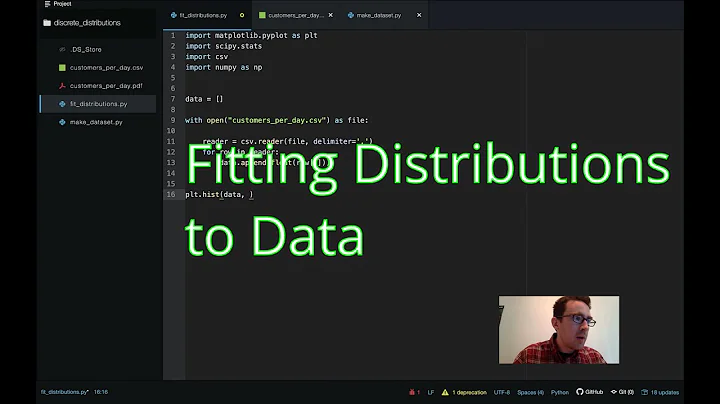Fitting distributions, goodness of fit, p-value. Is it possible to do this with Scipy (Python)?
Solution 1
In SciPy documentation you will find a list of all implemented continuous distribution functions. Each one has a fit() method, which returns the corresponding shape parameters.
Even if you don't know which distribution to use you can try many distrubutions simultaneously and choose the one that fits better to your data, like in the code below. Note that if you have no idea about the distribution it may be difficult to fit the sample.

import matplotlib.pyplot as plt
import scipy
import scipy.stats
size = 20000
x = scipy.arange(size)
# creating the dummy sample (using beta distribution)
y = scipy.int_(scipy.round_(scipy.stats.beta.rvs(6,2,size=size)*47))
# creating the histogram
h = plt.hist(y, bins=range(48))
dist_names = ['alpha', 'beta', 'arcsine',
'weibull_min', 'weibull_max', 'rayleigh']
for dist_name in dist_names:
dist = getattr(scipy.stats, dist_name)
params = dist.fit(y)
arg = params[:-2]
loc = params[-2]
scale = params[-1]
if arg:
pdf_fitted = dist.pdf(x, *arg, loc=loc, scale=scale) * size
else:
pdf_fitted = dist.pdf(x, loc=loc, scale=loc) * size
plt.plot(pdf_fitted, label=dist_name)
plt.xlim(0,47)
plt.legend(loc='upper left')
plt.show()
References:
- Distribution fitting with Scipy
- Fitting empirical distribution to theoretical ones with Scipy (Python)?
Solution 2
import numpy as np
import pandas as pd
import scipy.stats as st
import statsmodels.api as sm
import matplotlib as mpl
import matplotlib.pyplot as plt
import math
import random
mpl.style.use("ggplot")
def danoes_formula(data):
"""
DANOE'S FORMULA
https://en.wikipedia.org/wiki/Histogram#Doane's_formula
"""
N = len(data)
skewness = st.skew(data)
sigma_g1 = math.sqrt((6*(N-2))/((N+1)*(N+3)))
num_bins = 1 + math.log(N,2) + math.log(1+abs(skewness)/sigma_g1,2)
num_bins = round(num_bins)
return num_bins
def plot_histogram(data, results, n):
## n first distribution of the ranking
N_DISTRIBUTIONS = {k: results[k] for k in list(results)[:n]}
## Histogram of data
plt.figure(figsize=(10, 5))
plt.hist(data, density=True, ec='white', color=(63/235, 149/235, 170/235))
plt.title('HISTOGRAM')
plt.xlabel('Values')
plt.ylabel('Frequencies')
## Plot n distributions
for distribution, result in N_DISTRIBUTIONS.items():
# print(i, distribution)
sse = result[0]
arg = result[1]
loc = result[2]
scale = result[3]
x_plot = np.linspace(min(data), max(data), 1000)
y_plot = distribution.pdf(x_plot, loc=loc, scale=scale, *arg)
plt.plot(x_plot, y_plot, label=str(distribution)[32:-34] + ": " + str(sse)[0:6], color=(random.uniform(0, 1), random.uniform(0, 1), random.uniform(0, 1)))
plt.legend(title='DISTRIBUTIONS', bbox_to_anchor=(1.05, 1), loc='upper left')
plt.show()
def fit_data(data):
## st.frechet_r,st.frechet_l: are disbled in current SciPy version
## st.levy_stable: a lot of time of estimation parameters
ALL_DISTRIBUTIONS = [
st.alpha,st.anglit,st.arcsine,st.beta,st.betaprime,st.bradford,st.burr,st.cauchy,st.chi,st.chi2,st.cosine,
st.dgamma,st.dweibull,st.erlang,st.expon,st.exponnorm,st.exponweib,st.exponpow,st.f,st.fatiguelife,st.fisk,
st.foldcauchy,st.foldnorm, st.genlogistic,st.genpareto,st.gennorm,st.genexpon,
st.genextreme,st.gausshyper,st.gamma,st.gengamma,st.genhalflogistic,st.gilbrat,st.gompertz,st.gumbel_r,
st.gumbel_l,st.halfcauchy,st.halflogistic,st.halfnorm,st.halfgennorm,st.hypsecant,st.invgamma,st.invgauss,
st.invweibull,st.johnsonsb,st.johnsonsu,st.ksone,st.kstwobign,st.laplace,st.levy,st.levy_l,
st.logistic,st.loggamma,st.loglaplace,st.lognorm,st.lomax,st.maxwell,st.mielke,st.nakagami,st.ncx2,st.ncf,
st.nct,st.norm,st.pareto,st.pearson3,st.powerlaw,st.powerlognorm,st.powernorm,st.rdist,st.reciprocal,
st.rayleigh,st.rice,st.recipinvgauss,st.semicircular,st.t,st.triang,st.truncexpon,st.truncnorm,st.tukeylambda,
st.uniform,st.vonmises,st.vonmises_line,st.wald,st.weibull_min,st.weibull_max,st.wrapcauchy
]
MY_DISTRIBUTIONS = [st.beta, st.expon, st.norm, st.uniform, st.johnsonsb, st.gennorm, st.gausshyper]
## Calculae Histogram
num_bins = danoes_formula(data)
frequencies, bin_edges = np.histogram(data, num_bins, density=True)
central_values = [(bin_edges[i] + bin_edges[i+1])/2 for i in range(len(bin_edges)-1)]
results = {}
for distribution in MY_DISTRIBUTIONS:
## Get parameters of distribution
params = distribution.fit(data)
## Separate parts of parameters
arg = params[:-2]
loc = params[-2]
scale = params[-1]
## Calculate fitted PDF and error with fit in distribution
pdf_values = [distribution.pdf(c, loc=loc, scale=scale, *arg) for c in central_values]
## Calculate SSE (sum of squared estimate of errors)
sse = np.sum(np.power(frequencies - pdf_values, 2.0))
## Build results and sort by sse
results[distribution] = [sse, arg, loc, scale]
results = {k: results[k] for k in sorted(results, key=results.get)}
return results
def main():
## Import data
data = pd.Series(sm.datasets.elnino.load_pandas().data.set_index('YEAR').values.ravel())
results = fit_data(data)
plot_histogram(data, results, 5)
if __name__ == "__main__":
main()
Related videos on Youtube
s_sherly
Updated on June 01, 2022Comments
-
s_sherly almost 2 years
INTRODUCTION: I'm a bioinformatician. In my analysis which I perform on all human genes (about 20 000) I search for a particular short sequence motif to check how many times this motif occurs in each gene.
Genes are 'written' in a linear sequence in four letters (A,T,G,C). For example: CGTAGGGGGTTTAC... This is the four-letter alphabet of genetic code which is like the secret language of each cell, it’s how DNA actually stores information.
I suspect that frequent repetitions of a particular short motif sequence (AGTGGAC) in some genes are crucial in a specific biochemical process in the cell. Since the motif itself is very short it is difficult with computational tools to distinguish between true functional examples in genes and those that look similar by chance. To avoid this problem I get sequences of all genes and concatenated into a single string and shuffled. The length of each of the original genes was stored. Then for each of the original sequence lengths, a random sequence was constructed by repeatedly picking A or T or G or C at random from the concatenated sequence and transferring it to the random sequence. In this way, the resulting set of randomized sequences has the same length distribution, as well as the overall A,T,G,C composition. Then I search for the motif in these randomized sequences. I performed this procedure 1000 times and averaged the results.
- 15000 genes that do not contain a given motif
- 5000 genes that contain 1 motif
- 3000 genes that contain 2 motifs
- 1000 genes that contain 3 motifs
- ...
- 1 gene that contain 6 motifs
So even after 1000 times randomization of true genetic code, there aren't any genes which have more than 6 motifs. But in the true genetic code, there are a few genes which contain more then 20 occurrences of the motif, which suggest that these repetition might be functional and it's unlikely to find them in such an abundance by pure chance.
PROBLEM:
I would like to know the probability of finding a gene with let's say 20 occurrences of the motif in my distribution. So I want to know the probability to find such a gene by chance. I would like to implement this in Python, but I don't know how.
Can I do such an analysis in Python?
Any help would be appreciated.
-
eat almost 13 yearsPlease note that you have modified substantially your question. Would it be possible to revert this question to your original question plus a clear 'update' section for all of the new details? Or perhaps just a new question? Thanks
-
 srodriguex over 9 yearsThe code above throws me the following message error: "AttributeError: 'module' object has no attribute 'arcsineweibull_min'" on the "dist = getattr(scipy.stats, dist_name)" statement. My versions are: scipy is 0.13.3, numpy is 1.8.0, matplotlib is 1.3.1.
srodriguex over 9 yearsThe code above throws me the following message error: "AttributeError: 'module' object has no attribute 'arcsineweibull_min'" on the "dist = getattr(scipy.stats, dist_name)" statement. My versions are: scipy is 0.13.3, numpy is 1.8.0, matplotlib is 1.3.1. -
 Saullo G. P. Castro over 9 years@srodriguex thank you! There was a small typo and I just fixed it
Saullo G. P. Castro over 9 years@srodriguex thank you! There was a small typo and I just fixed it -
 diffracteD almost 9 years@SaulloCastro How can I apply this
diffracteD almost 9 years@SaulloCastro How can I apply thisfit()function for a 3D-surface-fitting, i just achieved usingscipy.linalg.lstsq? How would I confirm that I got a good fit over data. thank you. -
Khris almost 5 yearsThis example doesn't work anymore properly, can you update it?
-
 Saullo G. P. Castro almost 5 years@Khris I will try to find some time to work on it. Feel free to edit if you already know what is incompatible with the new SciPy package...
Saullo G. P. Castro almost 5 years@Khris I will try to find some time to work on it. Feel free to edit if you already know what is incompatible with the new SciPy package... -
Khris almost 5 years@SaulloG.P.Castro Okay, I've been playing with this. The code DOES still work but the
arcsine-fit is broken for some reason. Probably changes in the function call. Also the other functions look partly very different from your image, their fit is much better now. -
 Saullo G. P. Castro almost 5 years@Khris okay, hope the answer was helpful for you .... I will look into these updates once I find some time regards
Saullo G. P. Castro almost 5 years@Khris okay, hope the answer was helpful for you .... I will look into these updates once I find some time regards








